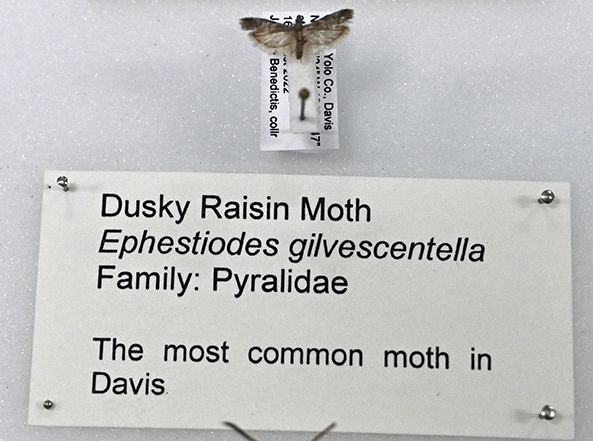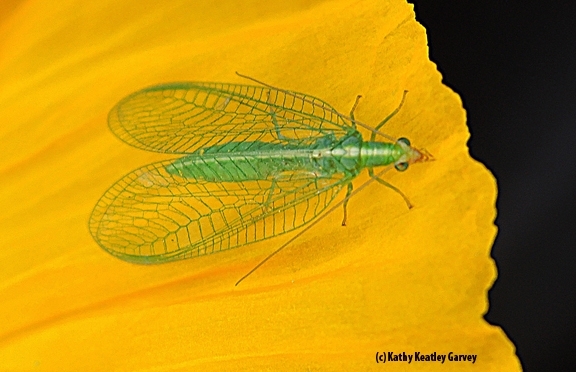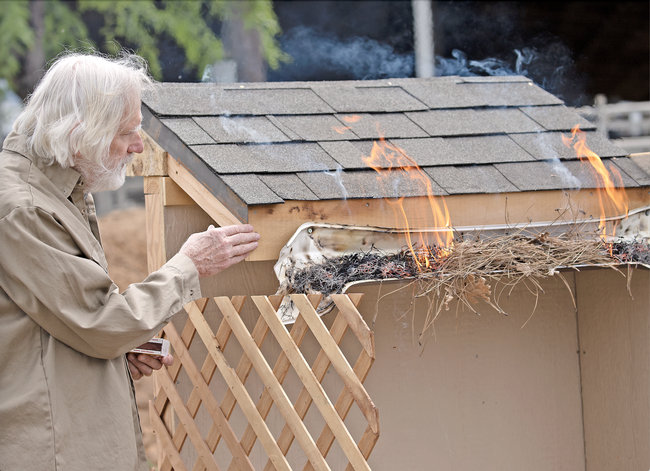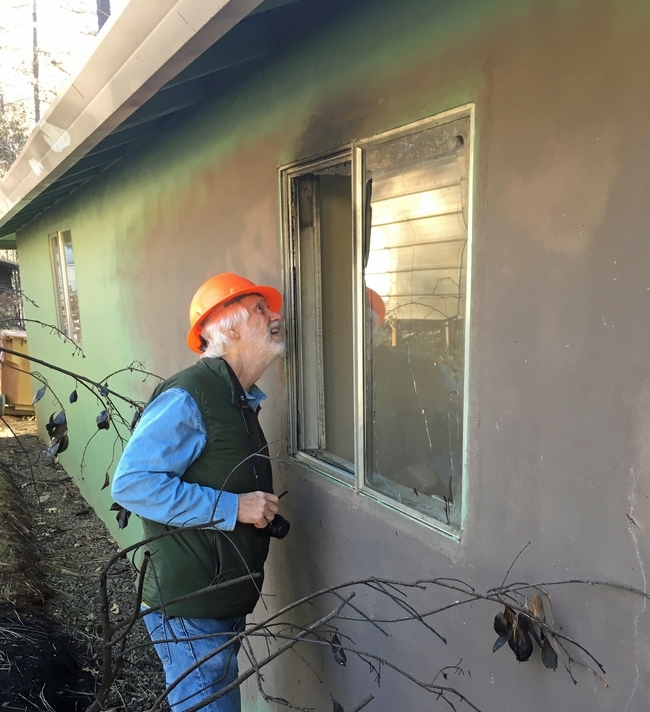- (Focus Area) Environment
- Author: Kathy Keatley Garvey

That was a key question asked at the Bohart Museum of Entomology's annual Moth Night, held both indoors and outdoors on the UC Davis campus on Saturday, July 20.
Doctoral student Iris Quayle of the laboratory of Professor Jason Bond, director of the Bohart (and the Evert and Marion Schlinger Endowed Chair of UC Davis Department of Entomology and Nematology, and associate dean, Agricultural Sciences, UC Davis College of Agricultural and Environmental Sciences), staffed a station explaining the differences.
Some major points:
- Both butterflies and moths are members of the order Lepidoptera and both are pollinators.
- Both go through a complete metamorphosis, from egg to larva (caterpillar) to pupa to adult. Butterflies pupate in a chrysalis while a moth pupates in a cocoon.
- A butterfly's antennae have club-like tips whereas moths have feathery, thick, comb-like antennae.
- Butterflies are diurnal or active during the day, while moths are generally active at night. But some moths, including the white-lined sphinx moth, are both diurnal and nocturnal (active at night).
- Generally, a butterfly's wings are brightly colored and moths are dull in color, but not always. Some moths, such as the Ranchman's tiger moth, are beautifully colored.
Globally, scientists have described about 18,000 species of butterflies and 180,000 species of moths, "and hundreds of newly named species are added every year," according to Jeff Smith, curator of the Lepidoptera collection at the Bohart. "It's also believed that we may know of no more than 10-15 percent of the species actually out there, with the small 'micro-Lepidoptera' likely with over 90 percent of the species in the world still unknown. This emphasizes the importance of preserving natural environments so things don't go extinct before we can ever recognize their importance to the Earth and their relationships in their habitats."
The Bohart Museum's global collection of 8 million insects includes some 825,454 specimens of moths and butterflies, including 618,750 moths, ranging in size from the huge Atlas moths (10-inch wingspan) to the extremely tiny (4 mm wingspan) leafminer moths.
Founded in 1946, the Bohart Museum is located in Room 1124 of the Academic Surge Building, 455Crocker Lane, UC Davis campus. The open houses are free and family friendly. The next open house is on Saturday, Sept. 28 from 1 to 4 p.m. The theme: "Museum ABC's: Arthropods, Bohart and Collecting." Check out the website at https://bohart.ucdavis.edu or email bmuseum@ucdavis.edu for more information.



- Author: Kathy Keatley Garvey
The insects, that is.
Bohart Museum of Entomology research associate John "Moth Man" De Benedictus and colleagues set up a blacklighting display during the Bohart's annual Moth Night, held July 20, hoping to find a diversity of moths and other night-flying insects.
"We saw just three species," he said, listing them as:
- Pelochrista eburata, a tortricid moth with no common name
- Platynota stultana, a tortricid known as the Omnivorous Leafroller Moth, and
- Ephestiodes gilvescentella, a pyralid moth known as the Dusky Raisin Moth.
Entomologists study and collect nocturnal insects with blacklighting. They hang a white sheet, affix an ultraviolet light, and await the arrival of moths, beetles and other insects drawn to the light.
What else arrived from 10 to 11 p.m.? "Numerous small flies, a couple of earwigs, a large longhorn beetle (probably Prionus californicus), and a few green lacewings," he reported.
In comparison, the 2019 Moth Night resulted in these finds:
Family Tineidae:
Opogona omoscopa (Opogona crown borer)
Family Tortricidae:
Clepsis peritana
Platynota stultana (omnivorous leafroller)
Cydia latiferreana (filbertworm)
Family Pyralidae:
Achyra rantalis (garden webworm)
Ephestiodes gilvescentella (dusky raisin moth)
Cadra figuliella
Family Geometridae:
Digrammia muscariata
Family Noctuidae:
Spodoptera exigua (beet armyworm)
Spodoptera praefica (western yellow-striped armyworm)
Parabagrotis formais
De Benedictus has blacklighted for 37 years. His moth collection of some 600 species from the Stebbins Cold Canyon Reserve and 300 species from his backyard in Davis is housed in the Bohart Museum.

De Benedictus displayed his collection that includes the Dusky Raisin Moth, "the most common moth in Davis," he said. It's been recorded not only in California and Arizona, but in Oklahoma, Utah, Montana, Alberta an British Columbia. The moth is so named because its larvae feed on raisins (as well as prunes, walnuts, yeast and the like).
De Benedictus, who holds a master's degree in entomology (1998) from UC Berkeley, studied with major professor and noted entomologist Jerry Powell (1933-2023).
"Jerry Powell once estimated that there are about 17,000 North American butterflies and moths," De Benedictus commented. "I would not be surprised if it's closer to 20,000."

Every year De Benedictus helps coordinates the "Mid-Winter Lepidopterist Gatherings," a legacy of Powell. The gatherings are traditionally held annually at either the Essig Museum or the Bohart Museum "for colleagues to exchange information on moths and butterflies."
The Bohart Museum, located in Room 1124 of the Academic Surge Building, 455 Crocker Lane, is the home of a global collection of eight million insect specimens, plus a live petting zoo and a gift shop. Director is Professor Jason Bond, the Evert and Marion Schlinger Endowed Chair, UC Davis Department of Entomology and Nematology, and associate dean, Agricultural Sciences, UC Davis College of Agricultural and Environmental Sciences.
More information is available on the website at https://bohart.ucdavis.edu or by emailing bmuseum@ucdavis.edu.


- Author: Kathy Keatley Garvey

Did you know that there are 73 species of dragonflies (Anisoptera) in California?
We've been waiting for an updated field guide book on our state's dragonflies, and now it's here.
Dragonfly experts Kathy Biggs and Sandra von Arb have just announced their newly published book, Dragonflies (Anisoptera) of California,published by Nature/Field Guides. It's a 200-page, spiral-bound book, rich with images, and featuring ALL of the 73 known species of dragonflies in California (many of these dragonflies also inhabit nearby states).
We remember Biggs and von Arb sharing their expertise at a dragonfly open house at the Bohart Museum of Entomology, UC Davis, on Sept. 20, 2015 with international dragonfly authority Rosser Garrison, author of Dragonfly Genera of the New World: an llustrated and Annotated Key to the Anisoptera (now a retired insect biosystematist, California Department of Food and Agriculture); and Bohart associate Greg Kareofelas. UC Davis doctoral candidate Christofer Brothers also has shared his expertise on dragonflies at Bohart Museum open houses.
Biggs and von Arb relate they met through their shared passion for dragonflies. Biggs? An experienced dragonfly guide and author. Von Arb? A biologist and founder of the Biodiversity Education and Research Foundation, commonly known as BEAR or BEAR Foundation. (It is currently offline)
The authors point out that the book contains:
- More than 146 full-color photographs of both the males and females and their descriptions (photos also include nymph/exuvia for each genus)
- Habitat, distribution maps, flight periods, behaviors, similar species and oviposition techniques for each species
- Clear and easy-to-use format
Among the photographers contributing to the book are Pierre Deviche, Jim Johnson and Matthew Matthiessen. "Greg (Kareofelas) has a thumbnail showing a close-up of one of a snake tail faces showing the horns on the females," Biggs added.
You can order the book here. The link shows sample pages as well. It may be available soon from the Bohart Museum of Entomology gift shop, where Biggs also has dragonfly books.
Now, I'm waiting for that flameskimmer to snag a flying insect, just as its ancestors did. Dragonflies existed before the Age of Dinosaurs; dinosaurs lived during the Mesozoic Era (and that was 252 to 66 million years ago). Indeed, fossil records show that these dragonfly ancestors were the world's largest flying insects, some with wing spans measuring three feet.



- Author: Kathy Keatley Garvey
When a newly eclosed Western tiger swallowtail, Papilio rutulus, lands on a butterfly bush, the colors are striking.
The yellow and black butterfly contrasts well on the purple blossoms of Buddleja davidii.
While the majestic butterfly is widely loved, the plant, also called summer lilac, is not. It's considered an ecological threat and a noxious weed by the Invasive Plant Atlas of the United States: "Buddleja davidii readily invades disturbed sites and riparian areas. Although butterflies will use this plant as a nectar source their larvae cannot survive on it. By replacing native larval food source plants butterfly bush can have a negative impact on wildlife."
B. davidii is native to Sichuan and Hubei provinces in central China, and also Japan. The genus, Buddleja, is named for the Rev. Adam Buddle, an English botanist. The species name honors Father Armand David, a French missionary and explorer in China, Father Armand David, who was the first European to report the shrub, according to Wikipedia. It won the RHS Award of Merit in 1898, and the Award of Garden Merit (AGM) in 1941.
Now nurseries are selling non-invasive hybrids, with such names as "Lo and Behold" and "Blue Chip" and "Flutterby."
Nevertheless, who can resist photographing the Western tiger swallowtail as it stops to nectar on a butterfly bush?
Lo and behold...

- Author: Pamela S Kan-Rice
Priorities include removing objects within five feet of a house, upgrading vents
Wildfire losses cost taxpayers and communities hundreds of billions of dollars each year, and preparing communities before a disaster occurs is the best way to avoid damage to homes and neighborhoods. Retrofitting existing homes can make communities safer while avoiding billions in disaster costs.
As Californians learn to live with wildfire, scientists encourage improving the structure and design of houses and other buildings to help them survive wildfire. A new report shows that even inexpensive changes can increase wildfire resistance.
“Retrofitting a Home for Wildfire Resistance” suggests that some of the most effective strategies to reduce the vulnerability of homes and neighborhoods to wildfire can be done affordably.
“This report is a practical tool that helps evaluate the relative costs and benefits of fire-hardening retrofits,” said Yana Valachovic, a University of California Cooperative Extension forest advisor, who reviewed the study. “These retrofits can substantially improve the odds that a home or building will withstand wildfire exposures to embers, radiant heat or flame contact.”
The report is co-authored by Kimiko Barrett, wildfire research and policy analyst for Headwaters Economics, a non-partisan research organization based in Bozeman, Montana, and Stephen L. Quarles, UC Cooperative Extension advisor emeritus, who has studied the vulnerability of the built environment to wildfire exposures and potential mitigation strategies.
In partnership with California's Department of Forestry and Fire Protection, or CAL FIRE, Barrett and Quarles examined the costs for improving the structure and design of existing homes to increase their wildfire resistance.
“This tool can also help homeowners build a budget and prioritize tasks that often feel overwhelming,” Valachovic said. “Everyone should prioritize removing combustible vegetation, mulch, and stored materials within the first five feet of a structure and upgrading vents to resist embers.”
Simple actions can reduce a home's vulnerability to wildfire
The report's conclusions are derived from a detailed examination of the latest available science on mitigation strategies and construction costs. The authors identified costs for retrofitting structures to meet and exceed California's building code (Chapter 7A) for wildfire resistance, but the general principles and conclusions can be applied in other states, adjusting for local economic and supply conditions.
For a typical 2,000-square-foot home in California, retrofitting costs can range from $2,000 to upwards of $100,000 for the highest level of protection.
“When we looked at the latest building techniques and cost data, we found some effective retrofitting strategies can be done for between $2,000 to $10,000,” said Barrett. “While the highest level of protection can cost more, it is often not necessary. Simple actions such as removing flammable materials from near the home and removing debris from the roof can be done at little to no cost.”
The authors also incorporated effective mitigation strategies that could reduce risk without requiring costly upgrades over the entire home, such as replacing siding only on the side of a home that is close to another building, such as neighbor's home or a detached garage, or replacing combustible deck boards next to the home with a noncombustible deck board or metal grate.
They also incorporated a systems approach, where the vulnerability of adjacent components are considered, and recommend steps such as placing noncombustible surfaces at the intersection between two components.
For example, Quarles said: “Adding a gutter cover and ensuring the adjacent edge of roof is not vulnerable by incorporating a metal drip edge and, if necessary, a noncombustible bird stop at the edge of the roof. Or, replacing a combustible deck board next to the house and, if necessary, adding metal flashing at the base of the exterior wall.”
Cost estimates in the report include those for upgrading a home's exterior walls, roof, deck, windows, doors, eaves, gutters and near-home landscaping – all areas likely to be exposed to embers, direct flames and radiant heat.
“The graphics detailing specific elements of the retrofitting process are very useful,” Valachovic said.
Charts, architectural renderings and a detailed appendix of cost estimates provide a basis for a general understanding of the methods and budgets that homeowners might consider when retrofitting their home for wildfire resistance.
Retrofitting for wildfire can make communities safer
Contractors and others seeking information about building wildfire-resistant homes can gain valuable insights from this analysis, along with retrofit costs generated by the California Wildfire Mitigation Program.
“This analysis demonstrates that investing in wildfire-resistant retrofitting for homes is a cost-effective strategy to protect communities that could save billions in disaster costs,” said Barrett. “As more people live in fire-prone areas, we must also take a closer look at retrofitting homes to be stronger and more durable.”
While the authors hope Californians use the information to protect their homes, people who work in construction, development, design and policy also can use the information to show that retrofitting homes for wildfire resistance is an effective way to protect communities.
This 58-page report received funding from CAL FIRE and the U.S. Forest Service and can be downloaded for free at https://headwaterseconomics.org/wp-content/uploads/2024/06/Wildfire_Retrofit_Report_20240624.pdf.





